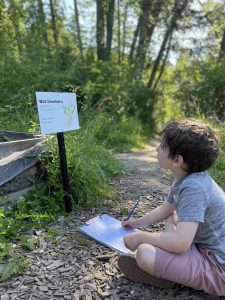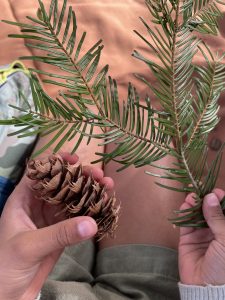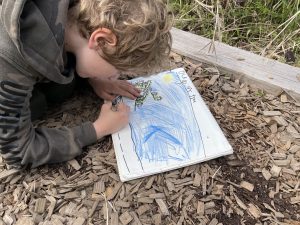I. General Information
School Name: Lochside Elementary
School District: SD#63 Saanich
Inquiry Team Members: Jenni Erickson: jerickson@saanichschools.ca,
Sarah Miller: sarahmiller@saanichschools.ca
Inquiry Team Contact Email: jerickson@saanichschools.ca
II. Inquiry Project Information
Type of Inquiry: NOIIE Case Study
Grade Levels Addressed Through Inquiry: Primary (K-3)
Curricular Areas Addressed: Language Arts – Literacy, Language Arts – Oral Language, Language Arts – Writing, Science
Focus Addressed: Indigenous understandings (for example, Traditional Knowledge, oral history, reconciliation), First Peoples Principles of Learning, Land, Nature or Place-based learning
In one sentence, what was your focus for the year? Exploring the connection between literacy development and nature-based learning experiences involving place-based Indigenous knowledge, storytelling, and learning through the natural environment.
III. Spirals of Inquiry Details
Scanning: During the scanning phase, we noticed that students entering Grade One had a strong base of storytelling through story workshop sessions in Kindergarten. We also noticed how most literacy instruction and exploration happened in the indoor environment. We wondered how building opportunities for storytelling in the outdoor environment, while connecting this to Indigenous land-based stories, might engage and support learners in their literacy development, oral language skills, understanding of Indigenous culture, and connection to the natural world. We used the four key questions to gather more information about this hunch. We discovered that most students felt connected to adults in the school, however, they did not always have a clear idea of what they were learning and why it was important. We incorporated First Peoples Principles of learning by forming strong relationships with each student so that we could connect to each student, hear their stories, and truly understand where they were at in their academic and social-emotional learning. We also noticed that experiential learning had a positive impact on engagement and motivation and wanted to incorporate this into all stages of the inquiry.
Focus: This year we focused on how opportunities to connect literacy activities with Indigenous knowledge, storytelling, and learning in the natural environment could support the literacy development of both Indigenous and non-Indigenous learners. We both have a passion for outdoor, place-based learning and over the past few years we have attempted to connect this with Indigenous knowledge and stories about the land. Our school resides on the traditional territory of the W̱SÁNEĆ Peoples, and we have been so grateful to be able to focus our learning on building connections to this place with our students. We were curious about how we could use this as a platform to engage students and intentionally connect it with oral and written literacy development.
Hunch: Our school does not have a large population of Indigenous students and, as such, we receive a proportionally smaller amount of support for Indigenous education. Indigenous education is largely left to the discretion of each classroom teacher. We had a hunch that Indigenous knowledge and ways of knowing were not being introduced as readily at our school, as they were at other schools in the district. The connection between Indigenous knowledge, environmental stewardship and literacy learning seemed to be an important focus for introducing all students, and especially Indigenous students, to Indigenous knowledge and ways of knowing.
New Professional Learning:
- Attending the NOIIE Symposium in April, 2023
- Learning about other Spirals of Inquiry Projects, and the inquiries and focus areas of other students and teachers was very inspiring.
- Expanding our own familiarity, understanding, and library of Indigenous stories and land-based knowledge and stories. We are learning and teaching on the traditional territory of the W̱SÁNEĆ Peoples, and began looking for local stories shared by W̱SÁNEĆ teachers and knowledge keepers, and extending to other Coast Salish stories and teachings as well.
- Learning from local W̱SÁNEĆ storyteller, Toby Joseph though school visits.
- Accessing Strong Nations Publishing, we were able to bring local and non-local Indigenous stories and non-fiction books into our classrooms, read them, and share them with our students during outdoor learning experiences.
- Working with our District’s Indigenous Education department, we extended our learning and resources with focused Indigenous Education collections (ex. ‘storytelling with puppets’ and ‘ethnobotany’).
Taking Action:
- Expanding our library of books and oral storytelling resources has been a very helpful and enriching process for our professional development. Listening, reading, and learning Indigenous stories has helped us become more confident and capable in retelling and sharing these stories with our students.
- Continuing to engage in repeated visits to the natural outdoor environment surrounding our school has continued to shift and change this year, as our own understanding of Indigenous stories and knowledge has grown. As we have listened and learned about W̱SÁNEĆ and other Indigenous place-based stories, we have been able to connect this knowledge with our outdoor learning program.
- Increasing our resources and knowledge of local Indigenous stories has helped us support our colleagues through meaningful conversations and access to these shared materials. For Indigenous Peoples Day, we were able to collaborate with other classes and teachers to provide sessions connecting outdoor learning, Indigenous stories, and knowledge of native species in the nature area called, ‘Beyond the Fence’.



Picture descriptions: Students engaging with the local environment, practicing SENĆOŦEN plant names and drawing plant characteristics, and responding to Indigenous stories and knowledge in their nature journals.
Checking: One of the strongest outcomes from this inquiry was an increased knowledge and understanding of Indigenous stories for both ourselves and our students. Students were consistently engaged and motivated by the local stories, and inspired to create their own stories afterwards. Their understanding of story structure and the purpose of oral legends increased. We saw this through their retellings of the stories, their own storytelling, as well as in their written recordings of stories. This also connected to an increased understanding and knowledge of the natural world through lessons learned through the stories. The lessons and knowledge found within the Indigenous stories were often repeated afterwards by the children. We would both like to continue with this work as we are just getting started in our own understanding and knowledge of local stories. We see the power and motivation these stories hold, and we would like to continue using them as a strong cultural connection and inspiration for all students, both Indigenous and non-Indigenous.
After asking students the four questions at the end of the year, we saw tremendous growth and richness when answering the question, “what are you learning and why is it important?” The profound tradition of Indigenous storytelling seemed to elevate the importance of the students’ own stories. At the end of the year, they could easily identify why their stories, and their learning, were important.
Reflections/Advice: A big takeaway from this inquiry is that we, as educators, need to do the hard work of educating ourselves on Indigenous history and culture, and seek out respectful ways to share and incorporate Indigenous knowledge into our teachings. We cannot expect all of this to be done by the Indigenous community. We hope to continue educating ourselves on Indigenous history, culture, and specifically, local land-based stories. We also hope to expand our knowledge of the SENĆOŦEN language, so that we can incorporate this into our classroom program as well.
When learning outdoors, we found the deep-rooted connections between Indigenous knowledge, nature, and story to be highly engaging and motivating for students. We would encourage other educators to find similar opportunities to explore their local environment and to connect this learning with Indigenous knowledge. Our advice to other schools would be to look for opportunities to build your own knowledge. At the same time, contact your district and local Indigenous community (through proper protocols) to slowly and respectfully build connections.
